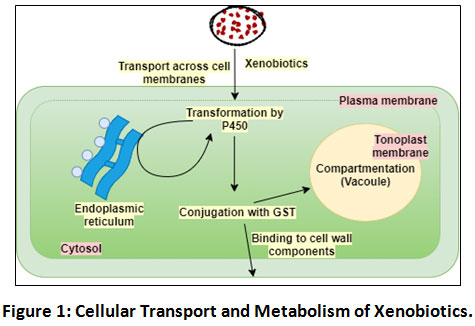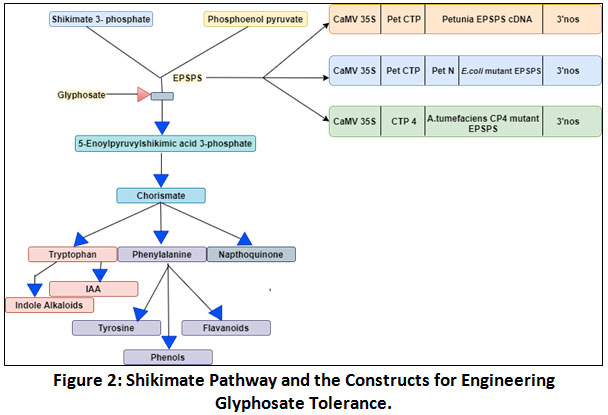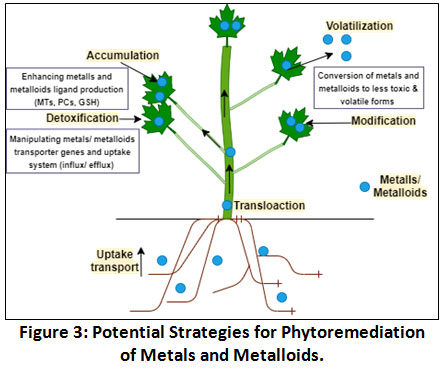Potential of Biotechnology in Phytoremediation
Corresponding author Email: misbahsidiquekhanam123@gmail.com
DOI: http://dx.doi.org/10.12944/CWE.16.2.26
Copy the following to cite this article:
Khan M, Mir J. I. Potential of Biotechnology in Phytoremediation. Curr World Environ 2021;16(1). DOI:http://dx.doi.org/10.12944/CWE.16.2.26
Copy the following to cite this URL:
Khan M, Mir J. I. Potential of Biotechnology in Phytoremediation. Curr World Environ 2021;16(1). Available From : https://bit.ly/3cQRWhC
Download article (pdf)
Citation Manager
Publish History
Select type of program for download
| Endnote EndNote format (Mac & Win) | |
| Reference Manager Ris format (Win only) | |
| Procite Ris format (Win only) | |
| Medlars Format | |
| RefWorks Format RefWorks format (Mac & Win) | |
| BibTex Format BibTex format (Mac & Win) |
Article Publishing History
| Received: | 06-09-2020 |
|---|---|
| Accepted: | 24-03-2021 |
| Reviewed by: | 
 Thangavelu Muthukumar
Thangavelu Muthukumar
|
| Second Review by: |

 Ladan Bayat
Ladan Bayat
|
| Final Approval by: | Dr. M. Rafatullah & Prof. S. C. Garkoti |
Introduction
The exploitation of plants, either directly or indirectly to mitigate the contamination of natural resources like soil and groundwater and improve their quality is called phytoremediation. It is found to be a perfect approach and an acceptable way to address the ever-increasing problem of environmental contamination. The accumulation of toxic substances in the soil is a global problem and the development of plant-based technologies exploiting the strategies of biotechnology is of significant interest. These transgenic approaches, introducing biodegradation capabilities of microbes and mammals into plants, pledge an efficient and eco-friendly approach to renewing the environment. Although there are innumerable applications of phytoremediation such as cost effectiveness, long term application, and other aesthetic advantages but there are certain limitations too that cannot be overseen. These include the introduction of contaminant or their metabolites into the food chain, mutagenesis, long clean-up times, assimilation of toxic substances, establishing and maintaining vegetation at waste sites.
Phytoremediation of Organics and Herbicides
Persistent organic pollutants (POPs) involving dioxins, trichloroethylene (TCE) and carbon tetrachloride (CCl4) and broad-spectrum herbicides like glyphosates, though play a major role in agriculture, also impact the environment negatively in the form of pollutants and toxicants. They may sorb to the roots followed by translocation and metabolism, which further leads to the hydrophobic interactions of these chemicals with the plant cell wall and plasma membrane, transporting them inside the cell via active transport [Fig 1].
The uptake of these chemicals is solely dependent on the plant’s uptake efficiency, the concentration of the chemicals in soil water, and the transpiration rate of the plant. The rate of chemical uptake by the plant (U) is given by the expression: U=(TSCF) (C) (T); where TSCF is the efficiency of uptake ranging from 0-1 (dimensionless), C is the soil water concentration of the chemical in mg/L and T is the transpiration rate in L/day.
An effective method of Phytoremediation involves an enhanced rate of chemical uptake by the plant, followed by the detoxification of the chemicals absorbed/ translocated. For instance, the introduction of the mammalian cytochrome p450 into rice plants to remediate atrazine. Similarly, improvement of the isoenzyme Glutathione S Transferase (GST) that catalyse the conjugation of ᵧ glutathione synthetase to alachlor in poplar plant resulting in its elimination. Alternatively, microbial genes encoding atrazine chlorohydrolase (atzZ) and 1-aminocyclopropane-1-carboxylate deaminase (for increasing root mass) have also shown promising results in phytoremediation.
Moreover, approaches involving the remediation of organic chemicals have been developed including the expression of cytochrome p450 such as human CYP2E1 in model plants (e.g., tobacco and poplar) where these GM plants have shown an increase in POP and TCE metabolism for chemicals like vinyl chloride, benzene, toluene, and chloroform. Furthermore, the use of bacterial genes like dhlAB for the degradation of 1, 2-dichlorethane from Xanthobacter is known to enhance removal of this compound in plants.
 |
Figure 1: Cellular Transport and Metabolism of Xenobiotics. Click here to view Figure |
Herbicide Tolerance (Glyphosate Tolerance)
Plants that can tolerate herbicides are called herbicide-resistant plants.
 |
Figure 2: Shikimate Pathway and the Constructs for Engineering Glyphosate Tolerance. Click here to view Figure |
Glyphosate, a broad-spectrum herbicide, is a glycine (amino acid) derivative and acts as a substrate analogue or competitive inhibitor of the enzyme 5-enolpyruvylshikimate-3-phosphate synthase (EPSPS), an essential biocatalyst in the shikimic acid pathway. It thus hinders the biosynthesis of amino acids (Phe, tyr and trp), vitamins, and many secondary plant metabolites [Fig 2]. The various strategies implemented include; overexpression of the target protein (EPSPS), mutation of the target protein, enhanced plant detoxification, and detoxification of the herbicide using gene from a foreign source. As mentioned above, the xenobiotics are detoxified or eliminated by targeting pathways that involve hydroxylation, conjugation, and transport processes.
Phytoremediation of Metals and Metalloids
Some of the major pollutants that fall in this category include arsenic, mercury, and selenium.
Arsenic (As) being one of the major environmental pollutants, offers a more opportunistic approach for the researchers in terms of phytoremediation to clean up the environment more practically and cost-effectively. Considering the biotechnological strategies, various methods in the laboratory have shown elevated tolerance and elimination of As from the contaminated soil. This involves the expression of microbial genes such as ArsC from Escherichia coli combined with the co-expression of ᵧ-glutamylcysteine synthetase, which leads to the synthesis of glutathione (GSH), causing subsequent conjugation of As.
Yet another approach involves the translocation to the leaves through efflux homolog of the gene, ArsB followed by volatilization of arsenic by its methylation to trimethylarsine by incorporating ArsM gene.
Another potential pollutant, selenium (Se) which is also a naturally found micronutrient in the soil, becomes extremely toxic at high concentrations. Being chemically similar to sulphur (S), it is hypothesized that the toxicity might be consequential to the substitution of S with Se in the proteins. The development of GM plants implies the expression of certain enzymes, wherein methylation of Se derivatives prevents the substitution reaction and converts these to more volatile forms to be removed from the soil.
Mercury (Hg) which also causes deadly, mercury poisoning is a highly toxic environmental pollutant. Depending upon the form of Hg i.e., either elemental or organomercurial, the toxicity varies from being less to highly toxic respectively. The biotechnological approach to deal with such unwanted accumulation in the environment involves the use of some bacteria, expressing genes such as merA and merB encoding Hg ion reductase and organomercurial lyase respectively. Furthermore, the expression is enhanced by the localized expression of these genes in the chloroplasts via plastid engineering, in the absence of gene silencing. In tobacco plants, expressing these genes efficiently, enhanced resistance to phenyl mercury acetate is observed and they also show efficient volatilisation of elemental Hg after the translocation of organic Hg [Fig 3].
 |
Figure 3: Potential Strategies for Phytoremediation of Metals and Metalloids. Click here to view Figure |
Phytoremediation of Explosives
Explosives like 2,4,6-trinitrotoluene (tnt), hexahydro-1,3,5-trinitro-1,3,5-triazine (RDX), and glyceryl trinitrate (GTN) are some of the persistent polluting contaminants worldwide, found especially in the military sites, manufacturing sites, and conflict areas, where they majorly contribute towards the soil, air, and groundwater contamination. Various transgenic plants have been developed for eliminating these pollutants from the environment through phytoremediation. It implies the use of certain bacterial nitroreductases (pnrA) and cytochrome p450 genes which increases the tolerance, uptake, and detoxification of these explosives.
The exploitation of certain model plants like Arabidopsis for such experiments have shown promising results for cleaning up the environment.
Phytoremediation of Pesticides and Transgenic Crops
According to data compiled by various concerned organizations, over thousands of compounds are used as pest control agents, representing numerous organo chemical classes: carbamates, thiocarbamates, organophoshates, dipyridyls, triazines, phenoxyacetates, coumarins, nitrophenols, pyrazoles, pyrethroids, and several other organic compounds containing chlorine, phosphorus, tin, mercury, arsenic, copper, etc. In fact, millions of tons of pesticides are synthesized and used annually in close association with agriculture and horticulture which in turn cause severe environmental impact.
As discussed earlier, overexpression of genes involved in metabolism, uptake and transport of pollutants in plants is a suitable method of increasing the efficacy of phytoremediation.
Additionally, the expression of suitable genes in root system enhances the rhizodegradation of PCBs and PAHs, which developed the idea to amplify plant biodegradation of xenobiotics by genetic manipulation. Genes from various sources like humans, microbes, plants, and animals are being successfully utilized for this venture. The transformation of these genes can be readily achieved for many plant varieties using approaches such as Agrobacterium tumefaciens-mediated plant transformation, Biolistic method of gene transfer, etc.
GM or Transgenic plants developed by Biotechnological approaches can be used for efficient phytoremediation of pollutants. Earlier, the commercially available GM plants were produced to minimize the loss of crop yield due to insect damage (particularly larvae) at the same time as reducing the amount of pesticides required (e.g., plants expressing Bt toxin). However, transgenic plants for phytoremediation were first developed for remediating heavy metal contaminated soil sites; for example, Nicotiana tabaccum expressing a yeast metallothionein gene for higher tolerance to Cd, or Arabidopsis thaliana overexpressing a Hg reductase gene for higher tolerance to Hg. Several other plants have been developed over the years with either transgene inserts, responsible for the metabolization of xenobiotics or increased resistance of a number of pollutants.
Limitations and Future Directions
Although several significant approaches have been made in the field of metagenomics to enhance the phytoremediation of the undesired pollutants in our environment one of the major drawbacks of the transgenic approaches includes the unforeseen pleiotropic effects of these transgenes into the plant. This is due to the presence of complex metabolic pathways in plant systems that are directly or indirectly interlinked to each other and even a single manipulation can have a huge impact on the homeostatic system of the plant or even the entire food chain.
Additionally, the ethical concerns associated with gene containment cannot be overlooked either.
However, to make real progress a system-wide approach, considering the entire plant metabolic pathways should be developed. The recent advances in CRISPR/dCas based gene-editing tools also provide insights into a wide range of plant genomics research. It can be implemented in gene activation, repression, epigenome editing, and many other possible manipulations in the genome. This requires in-depth knowledge about the pleiotropic effects of the target genes and the metabolic pathways involved. The advanced knowledge will allow phytoremediation to be applied more effectively, without any significant side effects or yield drag.
Acknowledgment
I’d like to thank Dr. Soma Chaki, HoD Biotechnology, M.S. Ramaiah University of Applied Sciences, Bangalore for her invaluable support and guidance so far and Dr. Javid I Mir, Sr Scientist, Plant Biotechnology, ICAR-Central Institute of Temperate Horticulture for his suggestions and proofreading.
References
- V. M. Campos, I. Merino, R. Casado, L. F. Pacios and L. Gómez. Phytoremediation of organic pollutants. Spanish Journal of Agricultural Research (2008), DOI: 10.5424/sjar/200806S1-372.
CrossRef - Nouri, J., Khorasani, N., Lorestani, B. et al. Accumulation of heavy metals in soil and uptake by plant species with Phytoremediation potential. Environ Earth Sci 59, 315–323 (2009). https://doi.org/10.1007/s12665-009-0028-2.
CrossRef - Ellen L. Arthur, Pamela J. Rice, Patricia J. Rice, Todd A. Anderson, Sadika M. Baladi, Keri L. D. Henderson & Joel R. Coats. Phytoremediation— An Overview, Critical Reviews in Plant Sciences (2005), 24:2, 109-122, DOI: 10.1080/07352680590952496.
CrossRef - Dowling DN, Improving Phytoremediation through biotechnology, Current Opinion in Biotechnology (2009), doi: 10.1016/j.copbio.2009.03.007.
CrossRef - Doty SL, Shang TQ, Wilson AM, Tangen J, Westergreen AD, Newman LA, Strand SE, Gordon MP. Enhanced metabolism of halogenated hydrocarbons in transgenic plants containing mammalian cytochrome P450 2E1. Proc Natl Acad Sci USA 97:6287–6291 (2000).
CrossRef - Baerson S.R., Sanchez-Moreiras A., Pedrol-Bonjoch N., Schulz M., Kagan I.A., Agarwal A.K., Reigosa M.J., Duke S.O., 2005. Detoxification and transcriptome response in Arabidopsis seedlings exposed to the allelochemical benzoxazolin-2(3H)-one. J Biol Chem 280, 21867-21881.
CrossRef - Inui H., Shiota N., Motoi Y., Ido Y., Inque T., Kodama T., Ohkawa Y., Ohkawa H. Metabolism of herbicides and other chemicals in human cytochrome P450 species and in transgenic potato plants co-expressing human CYP1A1, CYP2B6 and CYP2C19. J Pest Sci 2001; https://doi.org/10.1002/ps.3871.
CrossRef - Edwards R., Dixon D.P. Plant glutathione transferases. Methods Enzymol. 2005; 401, 169-186.
CrossRef - Sandermann H. Higher plant metabolism of xenobiotics: the green liver concept. Pharmacogenet 1994; 4, 225-241.
CrossRef - Pollegioni L, Schonbrunn E, Siehl D. Molecular basis of glyphosate resistance-different approaches through protein engineering. FEBS J. 2011; 278(16): 2753-2766. doi:10.1111/j.1742-4658.2011.08214.
CrossRef - Scott P. Bizily, Clayton L. Rugh, Anne O. Summers, Richard B. Phytoremediation of methylmercury pollution: merB expression in Arabidopsis thaliana confers resistance to organomercurials. Meagher Proceedings of the National Academy of Sciences Jun 1999, 96 (12) 6808 6813; DOI: 10.1073/pnas.96.12.6808.
CrossRef - S.M. (2020) Phytoremediation of Explosives. In: Shmaefsky B. (eds) Phytoremediation. Concepts and Strategies in Plant Sciences. Springer, Cham. https://doi.org/10.1007/978-3-030-00099-8_8.
CrossRef - Lone MI, He ZL, Stoffella PJ, Yang XE. Phytoremediation of heavy metal polluted soils and water: progresses and perspectives. J Zhejiang Univ Sci B. 2008;9(3):210-220. doi:10.1631/jzus.B0710633.
CrossRef - Ansari AA, Gill SS, Gill R Lanza GR, Newman L, editors. 2015. Phytoremediation: management of environmental contaminants. Switzerland: Springer International Publishing.
CrossRef - B. van Aken and J. L. Schnoor, “Evidence of perchlorate (ClO4-) reduction in plant tissues (Poplar tree) using radio-labeled 36ClO4 −,” Environmental Science and Technology, vol. 36, no. 12, pp. 2783–2788, 2002.
CrossRef - J. S. Zhao, D. Fournier, S. Thiboutot, G. Ampleman, and J. Hawari, “Biodegradation and bioremediation of explosives,” in Applied Bioremediation and Phytoremediation, A. Singh and O. P. Ward, Eds., Springer, New York, NY, USA, 2004.
CrossRef - M. V. Cattaneo, J. C. Pennington, J. M. Brannon, D. Gunnison, D. W. Harrelson, and M. Zakikhani, “Natural attenuation of explosives,” in Remediation of Hazardous Waste Contaminated Soils, Marcel Dekker, New York, NY, USA, 2000.
- Mahdi Moradpour, Siti Nor Akmar Abdulah. CRISPR/dCas9 platforms in plants: strategies and applications beyond genome editing. Plant Biotechnology Journal (2019). https://doi.org/10.1111/pbi.13232.
CrossRef - Abhilash PC, Jamil S, Singh N. Transgenic plants for enhanced biodegradation and phytoremediation of organic xenobiotics. Biotechnol Adv. 2009 Jul-Aug;27(4):474-88. doi: 10.1016/j.biotechadv.2009.04.002. Epub 2009 Apr 14. PMID: 19371778.
CrossRef - Del Buono D, Terzano R, Panfili I, Bartucca ML. Phytoremediation and detoxification of xenobiotics in plants: herbicide-safeners as a tool to improve plant efficiency in the remediation of polluted environments. A mini-review. Int J Phytoremediation. 2020;22(8):789-803. doi: 10.1080/15226514.2019.1710817. Epub 2020 Jan 21. PMID: 31960714.
CrossRef - Bert V, Seuntjens P, Dejonghe W, Lacherez S, Thuy HT, Vandecasteele B. Phytoremediation as a management option for contaminated sediments in tidal marshes, flood control areas and dredged sediment landfill sites. Environ Sci Pollut Res Int. 2009 Nov;16(7):745-64. doi: 10.1007/s11356-009-0205-6. Epub 2009 Jun 16. PMID: 19533193.
CrossRef - Liu S, Yang B, Liang Y, Xiao Y, Fang J. Prospect of phytoremediation combined with other approaches for remediation of heavy metal-polluted soils. Environ Sci Pollut Res Int. 2020 May;27(14):16069-16085. doi: 10.1007/s11356-020-08282-6. Epub 2020 Mar 16. PMID: 32173779.
CrossRef






